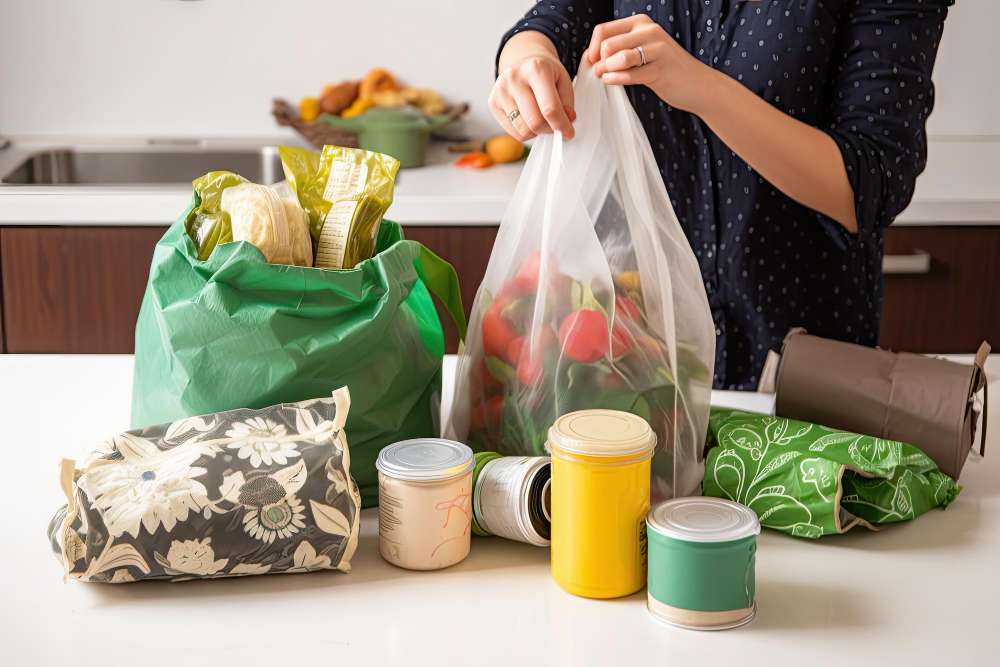
Thank you OXO for sponsoring this post; all opinions are my own.
Looking to cultivate a more sustainable kitchen, cut back on single use plastics or reduce your food waste impact (yes, yes, yes to all of the above!)? Below you’ll find a collection of 4 very doable things that will allow you to do just that – lighthearted, but lasting lifestyle shifts meant to spark more. A lot of pressure? Remember, the goal isn’t perfection, but progress.
1. OPT FOR UNPACKAGED FOOD
While it can feel nearly impossible to leave a market package free – with endless aisles of our favorite snacks, proteins, produce, and everything in between pre-wrapped and ready to adorn our pantries and refrigerators- there are small steps we can take to opt for more unpackaged options.
- Buy From Bulk: many grocery stores now offer bulk sections – big bins perfect for stocking up on nonperishables like dried grains, legumes, nuts, seeds, and fruits. Buying from bulk allows opportunity to purchase just what you need – reducing likelihood of food waste and often saving you money – and you can go packaging free while doing it. Instead of reaching for a paper or plastic bag at your shop, consider bringing your own jars or sacks instead (or even, reusing packaging from a previous purchase!). Just stop by customer service before you fill up, so they can tare your containers.
- Whole Produce > Precut: instead of reaching for pre-cubed squash, a pre-shredded cabbage, or even baby carrot sticks, consider purchasing whole produce. A whole option is usually more fresh -who knows how long that sliced celery’s been sitting- and often comes package free. To extend the shelf life, keep stored in an OXO Green Saver – these Produce Keepers feature enhanced carbon filters that trap and absorb ethylene gas (as they sit, fruits and vegetables give off ethylene gas; ethylene gas speeds up the ripening process), while allowing proper airflow and humidity balance, so produce don’t perish before we have opportunity to eat them.
- Get Cooking: this concept is often easier said than actualized – especially balancing busier workweeks, families, life- but opting for a homemade option, instead of a prepared meal or snack, will help reduce kitchen waste. A few favorite and very simple recipes include these Family Friendly Overnight Oats, Seed Butter Bites, and Oil Free Roasted Roots (each made entirely from package free and bulk section accessible ingredients).
2. PURCHASE WITH PURPOSE
Yes, it will take a few extra minutes of effort, but next time you’re planning on picking up or ordering groceries, put together a very detailed list of what you need. Specific staples, ingredients for a recipe, snacks, splurges. Keeping in mind there are only so many opportunities to eat in a day, and shelf life. Shopping with a plan allows you to purchase with purpose, so you’re less likely to snag unnecessary impulses that may go bad before you get to them.
3.CONSIDER COMPOSTING
Admittedly, it took Andrew and I years to fall into composting – we’ve had a longtime commitment to reducing our food waste and general environmental impact, but somehow still, the practice felt unintuitive, complicated, and intensive. Until it didn’t. Little did we realize composting could be as simple as welcoming a sleek little bin, like OXO’s Compost Bin, lined with a compostable trash bag, to our kitchen counter. Flipped open whenever we’re cooking, we use ours to collect inedible food scraps (we save edible for scrap stocks), those bits and pieces from onions or bananas or leftover bread that would otherwise end up in our trash can. Instead of throwing these food scraps away, contributing to unnecessary organic waste in landfills, composting reduces methane emissions, creates rich and natural fertilizers, and captures harmful volatile organic compounds (VOCs) from the air, aiding in carbon sequestration. So, where to begin?
- Compostable Waste: (not limited to) vegetable scraps like onion peels, garlic skins, and squash rinds. Fruit scraps like grape stems, banana and orange peels, and lemon seeds. Grains like stale bread and unwanted rice or beans. Coffee beans and grounds, and filters. Loose leaf tea. Nuts and seeds. Egg shells. Herbs and spices.
- Non-compostable Waste: Animal products, like butter and dairy, meat, and fat.
As mentioned, Andrew and I keep an OXO’s Compost Bin on our counter, to use as we need. We typically fill 2-3 2.5 gallon compostable trash bags each week, and store them in our freezer until we can drop them with a composting service. DC’s Department of Public Works doesn’t offer compost pickup, but there are a number of free options around the city that are easy and accessible for us. For those in the Washington, DC area, you can find a comprehensive list of where to drop your collected compost off, here. For those around the country, a simple google search should hopefully bring up options.
4. SUBSTITUTE SINGLE USE PLASTICS
Instead of opting for single use plastics, consider investing in longer term options: a reusable water bottle (and water filtration system) to keep handy and refill throughout your day. Metal straws to sip your favorite smoothie or iced espresso. Canvas bags or a larger backpack to carry your groceries. Glass jars or little sacks to store your bulk purchased items. And long lasting tupperware for prepared meals. OXO’s line of Smart Seal Glass Containers are perfect for just that – naturally BPA-free and leakproof, these borosilicate glass containers stack neatly in your fridge or freezer and nest in your cupboard while not in use. So we can use them again and again. And again! Keep these items in plain sight, so they’re not only part of your collection, but daily practice.
